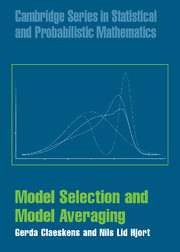Book contents
- Frontmatter
- Contents
- Preface
- A guide to notation
- 1 Model selection: data examples and introduction
- 2 Akaike's information criterion
- 3 The Bayesian information criterion
- 4 A comparison of some selection methods
- 5 Bigger is not always better
- 6 The focussed information criterion
- 7 Frequentist and Bayesian model averaging
- 8 Lack-of-fit and goodness-of-fit tests
- 9 Model selection and averaging schemes in action
- 10 Further topics
- Overview of data examples
- References
- Author index
- Subject index
Overview of data examples
Published online by Cambridge University Press: 05 September 2012
- Frontmatter
- Contents
- Preface
- A guide to notation
- 1 Model selection: data examples and introduction
- 2 Akaike's information criterion
- 3 The Bayesian information criterion
- 4 A comparison of some selection methods
- 5 Bigger is not always better
- 6 The focussed information criterion
- 7 Frequentist and Bayesian model averaging
- 8 Lack-of-fit and goodness-of-fit tests
- 9 Model selection and averaging schemes in action
- 10 Further topics
- Overview of data examples
- References
- Author index
- Subject index
Summary
Several real data sets are used in this book to illustrate aspects of the methods that are developed. Here we provide brief descriptions of each of these real data examples, along with key points to indicate which substantive questions they relate to. Key words are also included to indicate the data sources, the types of models we apply, and pointers to where in our book the data sets are analysed. For completeness and convenience of orientation the list below also includes the six ‘bigger examples’ already introduced in Chapter 1.
Egyptian skulls
There are four measurements on each of 30 skulls, for five different archaeological eras (see Section 1.2). One wishes to provide adequate statistical models that also make it possible to investigate whether there have been changes over time. Such evolutionary changes in skull parameters might relate to influx of immigrant populations. Source: Thomson and Randall-Maciver (1905), Manly (1986).
We use multivariate normal models, with different attempts at structuring for mean vectors and variance matrices, and apply AIC and the BIC for model selection; see Example 9.1.
The (not so) Quiet Don
We use sentence length distributions to decide whether Sholokhov or Kriukov is the most likely author of the Nobel Prize winning novel (see Section 1.3). Source: Private files of the authors, collected by combining information from different tables in Kjetsaa et al. (1984), also with some additional help of Geir Kjetsaa (private communication); see also Hjort (2007a).
Information
- Type
- Chapter
- Information
- Model Selection and Model Averaging , pp. 287 - 292Publisher: Cambridge University PressPrint publication year: 2008
